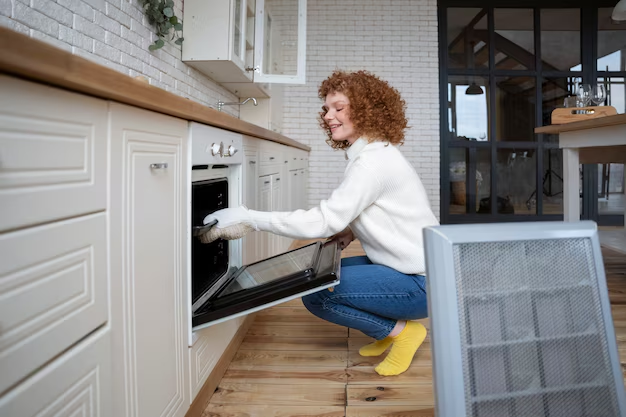Is 40 Degrees Cold Enough for a Refrigerator? Discover the Ideal Temperature Settings for Food Safety and Freshness
Setting the right temperature for your refrigerator is crucial not just for the longevity of the appliance, but more importantly, for the safety and freshness of your food. If you've ever wondered whether 40 degrees Fahrenheit is cold enough for a refrigerator, you're not alone. This question taps into core concerns about food preservation, energy efficiency, and appliance maintenance. Let's dive into why the ideal refrigerator temperature is a hot topic and what you need to know to keep your food safe.
🌡️ Understanding Safe Refrigerator Temperatures
What Is the Recommended Refrigerator Temperature?
The ideal temperature setting for a refrigerator is a topic of general consensus among experts. The U.S. Food and Drug Administration (FDA) suggests keeping your refrigerator at or below 40 degrees Fahrenheit (4 degrees Celsius). This threshold is crucial as it helps to inhibit bacterial growth, ensuring that perishable foods remain safe to consume.
Why 40 Degrees Fahrenheit?
The magic number, 40 degrees Fahrenheit, isn't arbitrary. Bacteria that cause foodborne illnesses grow most rapidly in the temperature range between 40 and 140 degrees Fahrenheit, often referred to as the "danger zone." By keeping your refrigerator at 40 degrees or lower, you're effectively slowing down the growth of these harmful pathogens.
How Accurate Are Refrigerator Thermostats?
Refrigerator thermostats can sometimes be imprecise. It's a good idea to use an appliance thermometer to ensure your fridge maintains the right temperature. Thermometers provide peace of mind and a simple tool to quickly verify that your refrigerator is operating within a safe range.
⚙️ Factors Influencing Refrigerator Temperature
Location and Load
Where your refrigerator is placed and how much it is filled can impact its cooling efficiency. Placement in areas with high ambient temperatures, or a fridge packed to the brim, can prevent cool air from circulating properly, leading to temperature inconsistencies.
- Location: Ensure your fridge is in a well-ventilated space, ideally not near heating elements like ovens or sunlight-exposed zones.
- Load: Keep your fridge moderately filled. A balance allows cool air to move efficiently around stored items.
Opening the Door
Every time the refrigerator door is opened, warm air enters, which can cause the internal temperature to rise temporarily. Frequent opening and closing can disrupt the cooling cycle.
- ⭐ Tip: Plan your fridge visits by grouping tasks to reduce the number of times you need to open the door.
Maintenance and Condition
Regular maintenance is essential for ensuring your refrigerator operates at its best. This includes cleaning the coils, checking door seals for leaks, and defrosting if necessary.
- Coils: Dust and debris on coils force your refrigerator to work harder to maintain its temperature.
- Seals: Worn-out door seals lead to air leaks, compromising internal temperature stability.
🥗 Keeping Food Safe and Fresh
Storing Food Properly
Proper storage not only protects your food from spoilage but also enhances taste and texture.
- Use Airtight Containers: Keeping foods in airtight containers minimizes exposure to air, slowing down spoilage.
- Organize Efficiently: Store raw meats on the bottom shelf to prevent drips from contaminating other foods.
- Label Expiry Dates: Always label leftovers and perishable items with their expiration dates to keep track of freshness.
Ideal Temperature Zones
Refrigerators have different temperature zones suited for specific types of food:
- Upper Shelves: Suitable for ready-to-eat foods like leftovers and prepared meals.
- Lower Shelves: Best for dairy products due to their need for consistent cold temperatures.
- Crisper Drawers: Designed to keep fruits and vegetables fresh longer by balancing humidity.
🌍 Energy Efficiency and Refrigerator Settings
Balancing Efficiency with Safety
Setting your refrigerator at an optimal temperature helps with energy efficiency, subsequently reducing utility bills. Operating your fridge at too cold a temperature can consume more energy unnecessarily, while a warmer setting could risk food safety.
- 🔋 Energy Tip: Regularly check the gasket seals for a proper fit and invest in energy-efficient models for long-term savings.
Modern Refrigerators and Smart Features
Newer refrigerator models often come equipped with smart features that aid in maintaining ideal temperatures automatically. Energy-efficient compressors, precise temperature controls, and digital displays ensure more consistent performance.
- Smart Features: Some fridges allow you to monitor and adjust settings remotely using apps. Look for features that offer both convenience and enhanced food safety.
🔍 Summary and Key Takeaways
In this comprehensive guide, we've unpacked the essentials of refrigerator temperatures, with a focus on the question: Is 40 degrees cold enough for a refrigerator? Here's a quick summary:
- 40 Degrees Fahrenheit (4°C): This is the recommended maximum for safe food storage, preventing rapid bacterial growth.
- Placement and Loading: Optimize placement and keep your fridge moderately filled to ensure even cooling.
- Maintenance: Regularly clean and check your fridge to maintain efficiency and performance.
- Food Safety: Use temperature zones effectively to store food types and maximize freshness.
- Energy Efficiency: A balance between safety and energy savings can be achieved with proper settings.
🔅 Tip Summary:
- Use a thermometer for accuracy.
- Store food smartly by utilizing different temperature zones.
- Repair and maintain your appliance regularly.
Final Insight
Maintaining the right refrigerator temperature is essential for preserving food safety, energy efficiency, and extending the lifespan of your appliance. By understanding how to properly set and monitor your refrigerator's conditions, you contribute to both a safer kitchen and a greener planet. The answer to "Is 40 degrees cold enough for a refrigerator?" is a qualified yes, with the assurance of consistent monitoring and smart usage habits. Your proactive steps help ensure that food remains fresh and flavorsome, avoiding waste and safeguarding health.
